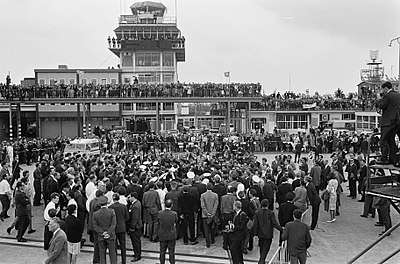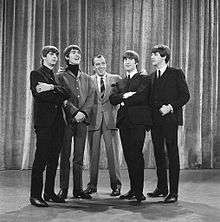Beatlemania

"Beatlemania" is the term given to the intense fan frenzy directed towards the English rock band the Beatles in the 1960s. Their popularity started growing in 1963, and by the next year, their tours were characterised by intense levels of hysteria and high-pitched screaming by female fans, both at concerts and during the band's travels.
From 1964 to 1970 in the US, the Beatles had the top-selling single one out of every six weeks, and the top-selling album one out of every three weeks. In 1966, the frenzy became so much that they stopped touring and became a studio-only band.
The use of the word "mania" to describe fandom predates the Beatles by more than 100 years. It has continued to be used to describe the popularity of musical acts, as well as popularity of public figures and trends outside the music industry.
Etymology
Beginning in 1841, fans of Hungarian pianist and composer Franz Liszt showed a level of fanaticism similar to that of the Beatles. Poet Heinrich Heine coined the word "Lisztomania" to describe this.[1] At the time, the word was used to indicate that the fan behaviour was a genuine mental illness—an implication that was not part of the later Beatlemania. Like the later Beatlemania, there was no agreement on why Liszt had such a fanatical fan base.
Origins
| History of the Beatles |
|---|
Andi Lothian, a former Scottish music promoter, claims that he coined the term Beatlemania while speaking to a reporter at the Caird Hall Beatles' Concert that took place as part of the Beatles' mini-tour of Scotland on 7 October 1963.[2][3] An early, printed use of the word is in The Daily Mirror, on 2 November 1963, in a news story headlined "BEATLEMANIA! It's happening everywhere... even in sedate Cheltenham", a report about the previous day's Beatles concert there; however, there is indication that the term was introduced even earlier, on 21 October, in The Daily Mail, for a feature story by Vincent Mulchrone headlined "This Beatlemania".[4]
The Beatles' publicist, Tony Barrow, credited 'the Press' for the term, but saw the phenomenon as beginning with the band's appearance on the London Palladium TV show on 13 October 1963, at which point he no longer had to contact the press, but had the press contacting him instead.[5] Maureen Lipman reported that after attending a concert in Hull that year, she heard that the arena "cleared away 40 pairs of abandoned knickers" from fellow young women fans.[6] On 3 January 1964, NBC-TV talk show host Jack Paar gave Americans their first prime-time glimpse of UK Beatlemania by showing clips of their concerts and crazed fans on his program.[7]

Beatlemania was already evident when the band arrived at John F. Kennedy International Airport in New York on 7 February 1964, but became common in the United States after the Beatles performed on three editions of The Ed Sullivan Show the same month; an estimated 73 million people tuned in to their February 9 appearance. Their tour of the U.S. was characterised by intense levels of hysteria and high-pitched screaming by female fans, both at concerts and during the band's travels. David P. Szatmary explains this phenomenon by showing the headlines of Billboard that made almost the entire US nation aware of Beatlemania. Some of the headline examples are: "The U.S. Rocks and Reels from 'Beatles' Invasion'"; "Chicago Flips Wig, Beatles' and Otherwise"; "New York City Crawling with Beatlemania" and "Beatle Binge in Los Angeles."[8] The extent of Beatlemania in the United States is evidenced by their sales. Szatmary states, "In the nine days, during the Beatles' brief visit, Americans had bought more than two million Beatles records and more than 2.5 million US dollars worth of Beatles-related goods. They purchased blue-and-white Beatles hats, Beatles T-shirts and beach shirts, Beatles tight-fitting pants, Beatles pajamas and three-button tennis shirts, Beatles cookies ..."[8]
During the 6½ years between the appearance of the "I Want to Hold Your Hand" single on the Billboard Hot 100 and the Let It Be LP, the Beatles had the Number One single in the US for a total of 59 weeks and topped the LP charts for 116 weeks. In other words, they had the top-selling single one out of every six weeks, and the top-selling album one out of every three weeks.[9] The Beatles inspired large numbers of people—especially female fans—to scream with enjoyment while their idols sang.[10][11]
The impact of the group was so sweeping that several musicians recorded albums made up of nothing but Beatles covers: Mary Wells in 1965 on her album Love Songs to The Beatles, which included "She Loves You" renamed "He Loves You"; bandleader Count Basie on 1966 album Basie's Beatle Bag; and the cartoon group The Chipmunks with The Chipmunks Sing the Beatles Hits. [12] Similarly, after the success of Beatles 65 in the US, several artists released albums with similar names, including Sinatra '65 by Frank Sinatra and Ellington '65 by Duke Ellington on Reprise Records, and Brasil '65 by Sérgio Mendes on the Capitol label.[13]
For The Beatles, the excitement of the mania wore off and by 1966, they were worn out by constant touring, press attention and concert crowds. George Harrison lamented, "The more fame we got, the more girls came to see us, everybody making a noise so that nobody could hear us."[14] The Beatles had also become major targets of public outcry for the first time when John Lennon's "More popular than Jesus" remark spread to the United States. The world experienced its last major Beatlemania event on 29 August 1966, at San Francisco's Candlestick Park when the band performed in front of a crowd of 25,000 at the conclusion of the Beatles' 1966 US Tour, marking their retirement from touring and live performances.[15]
Explanations
Cultural observers and psychologists have long speculated about why Beatlemania became so intense, even in comparison to other waves of celebrity fandom.
In February 1964, Paul Johnson wrote in The New Statesman—in an article that the magazine now describes as its "most complained-about piece"—that the mania was a modern incarnation of female hysteria and that the wild fans at the Beatles' concerts were "the least fortunate of their generation, the dull, the idle, the failures."[16] A 1966 study published in the British Journal of Clinical Psychology rejected this assertion. The researchers found that Beatles fans were not likelier to score higher on Minnesota Multiphasic Personality Inventory's hysteria scale, nor were they unusually neurotic. Instead, they described Beatlemania as "the passing reaction of predominantly young adolescent females to group pressures of such a kind that meet their special emotional needs."[17]
One factor in the intensity of Beatlemania may have been the Post–World War II baby boom, which gave the Beatles a larger audience of young fans than Frank Sinatra and Elvis Presley ever had a decade earlier.[18] Some commentators have argued that the Beatles' famous moptop haircuts signaled androgyny and thus presented a less threatening version of male sexuality to teenage girls intimidated by sex. They wore presentable suits and were seen as less "sleazy" than Elvis to middle-class whites.[19]
A popular narrative in Beatles literature is that the band's arrival in America was immaculately timed, with a nation mourning the assassination of John F. Kennedy and trying to rediscover its optimism. However, this narrative was challenged in a Slate column as being expedient and implicitly Americentric.[20]
Similar coinage
The term later became the name of various tribute bands dedicated to singing the songs of the Beatles, many with impersonators of the group.[21][22] The term has had a number of derivatives with the suffix "mania", usually short-lived, to describe a similar phenomenon toward other bands, such as "Rollermania"[23] in the early 1970s for the Scottish band Bay City Rollers, "Menudomanía" in the 1980s to describe frenzy across Latin America for the boyband Menudo and "Spicemania" in the 1990s for the Spice Girls.[24][25]
More recently, the "mania" suffix is often placed at the end of sports figures' names when they acquire sudden popularity, such as Hulkamania during the professional wrestling career of Hulk Hogan.
See also
- Beatlemania in the United Kingdom
- The Beatles in the United States
- Cultural impact of the Beatles
- The Beatles: Eight Days a Week – documentary film on the Beatles' peak touring years
- Kolya Vasin (stood at the origins of Beatlemania in the USSR)
References
- ↑ "Beatlemania: The screamers and other tales of Fandom", The Guardian, September 29, 2013.
- ↑ Radio interview Archived 7 October 2007 at the Wayback Machine., Radio Tay AM. Accessed 26 May 2007
- ↑ Video interview, The Courier. Accessed 7 October 2013
- ↑ "'BEATLEMANIA!'" Is Born", slate.com
- ↑ Gilliland, John (1969). "Show 27 - The British Are Coming! The British Art Coming!: The U.S.A. is invaded by a wave of long-haired English rockers. [Part 1]" (audio). Pop Chronicles. University of North Texas Libraries. Track 5.
- ↑ Lipman, Maureen (2014-08-28). "Forty pairs of abandoned knickers: Maureen Lipman on the Fab Four in Hull". The New Statesman. Retrieved 21 November 2014.
- ↑ "The Beatles". YouTube. Retrieved 23 September 2014.
- 1 2 Szatmary, David P. (2014). Rockin' in Time: A Social History of Rock-and-Roll. Pearson. p. 105.
- ↑ The Beatles Forever (1977), Nicholas Schaffner, McGraw-Hill Paperbacks, p. 216.
- ↑ Ehrenreich, B., Hess, E., & Jacobs, G. (1992). Beatlemania: Girls Just Want to Have Fun: The Adoring Audience: Fan Culture and Popular Media, 84-106.
- ↑ hl=en&lr=&id=lWSKAgAAQBAJ&oi=fnd&pg=PA84&dq=Beatlemania&ots=X1fpOVu19E&sig=pV5umk37w7tnwiiRkpU3kxexnL0#v=onepage&q=Beatlemania&f=false
- ↑ AllMusic: "The Chipmunks Sing the Beatles"
- ↑ "Boomers' First 'Must Have' Christmas Gift: Beatles '65". Huffington Post. 23 December 2014.
- ↑ Miles, Barry (Oct 27, 2009). The Beatles Diary Volume 1: The Beatles Years. Omnibus Press. p. 530.
- ↑ "Archived copy". Archived from the original on 26 May 2013. Retrieved 19 June 2013.
- ↑ Johnson, Paul (28 February 1964). "The Menace of Beatlism". New Statesman.
- ↑ A.J.W. Taylor (June 1966). "Beatlemania—A Study in Adolescent Enthusiasm". British Journal of Social and Clinical Psychology. 5 (2): 81–88. doi:10.1111/j.2044-8260.1966.tb00958.x.
- ↑ Lynskey, Dorian (28 September 2013). "Beatlemania: 'the screamers' and other tales of fandom". The Observer. Retrieved 23 September 2014.
- ↑ Barbara Ehrenreich, Elizabeth Hess and Gloria Jacobs (December 14, 1986). "Screams Heard 'Round The World". Chicago Tribune. Retrieved 23 September 2014.
- ↑ Hamilton, Jack (18 November 2013). "Did JFK's Death Make Beatlemania Possible?". Slate. Retrieved 23 September 2014.
- ↑ "Beatles Tribute band at". Beatlemanianow.com. Retrieved 9 September 2011.
- ↑ Jennifer Cantamessa, RJ Design. "Welcome to The Cast of Beatlemania". Moptops.com. Retrieved 9 September 2011.
- ↑ brizzle born and bred Paul Townsend+ Add Contact (1 December 2007). ""1975 Rollermania comes to town"". Flickr. Retrieved 9 September 2011.
- ↑ "Spice mania returns for reunion". BBC. 3 December 2007.
- ↑ "Why Spice Girls' Wannabe is the catchiest song of all time". BBC. 8 July 2016.
Further reading
- André Millard, Beatlemania: Technology, Business, and Teen Culture in Cold War America. Baltimore, MD: Johns Hopkins University Press, 2012.
- Candy Leonard, Beatleness: How The Beatles and Their Fans Remade The World, New York: Arcade Publishing, 2014.
- G. A. De Forest, Beach Boys versus Beatlemania: Rediscovering Sixties Music. Auckland, New Zealand: Best Books, 2007